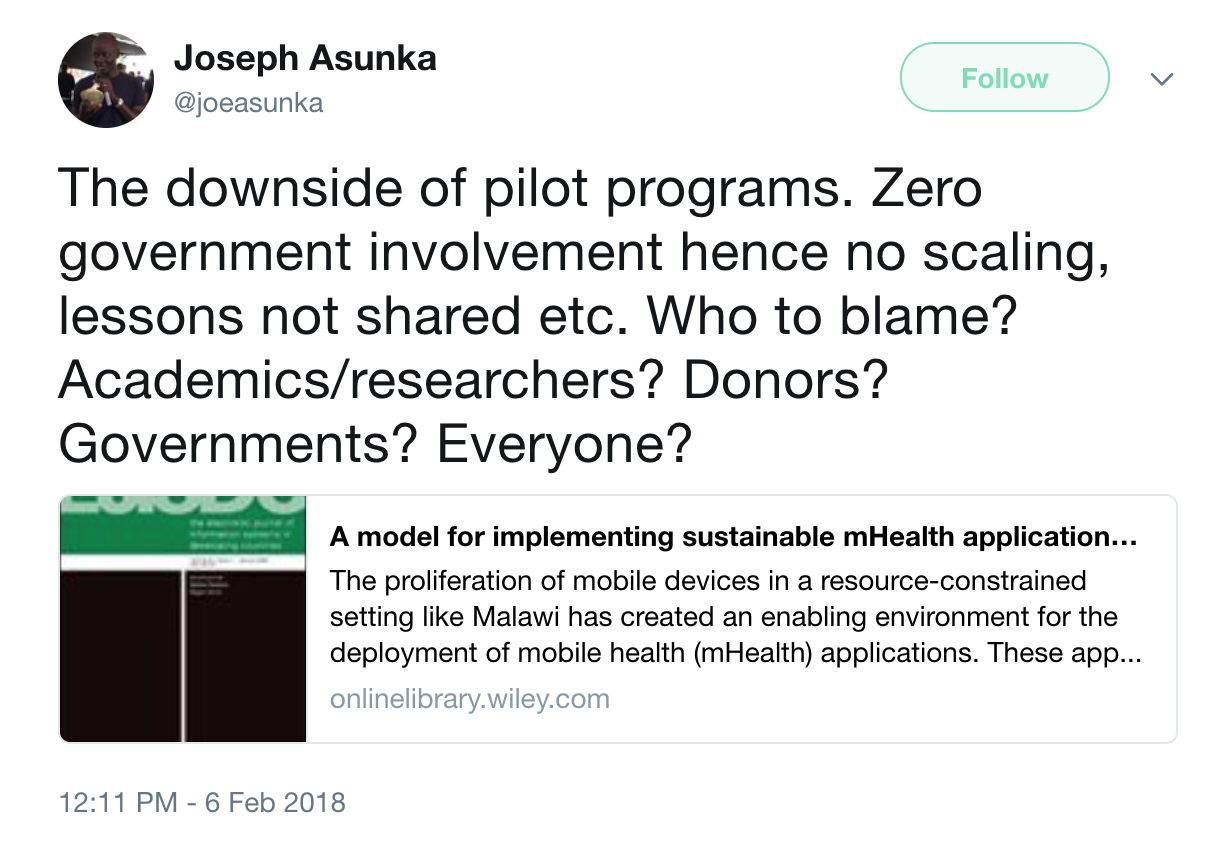Harnessing Technology at DFID: Takeaways from the New Digital Strategy
When it comes to technology and innovation, we often joke that the development sector lags at least 5 years behind the private sector. Worse still, in an effort to catch up, development agencies risk falling prey to fads, buzzwords, and endless jargon. The result is a staggering number of abandoned technology pilots, a paucity of evidence on what actually works, and a nagging feeling that technology is happening in spite of development agencies rather than being enabled by them. And all the while, a persistent digital divide risks making ICT programs a driver of inequality, not a tool for shared prosperity.
Last week, the UK’s Department for International Development (DFID) launched its new digital strategy – Doing Development in a Digital World – that is aimed to harness technology’s potential, while acknowledging and guarding against these risks. The strategy is far-reaching yet pragmatic, spanning a wide range of topics, from investments in corporate systems, to approaches for piloting and scaling emerging technology, and satellite data analysis, to name just a few.
Giving the strategy a quick read, we found a lot to like:
Avoiding tools-first approaches: The strategy is refreshingly free of buzzwords (admirably, a word search for “blockchain” turns up no results). Instead, it seeks to lay out good practices (largely centered around the Principles for Digital Development) for programme teams to identify the right tools for their own contexts.
Grounding digital innovation within sector strategies (for example, the EdTech research initiative and overall data-savvy approach outlined in DFID’s new Education Policy) and country office priorities (through the Digital Trailblazers initiative) prevent the strategy from becoming just another example of a well-intentioned HQ initiative that fizzles out due to country office indifference.

Testing, sharing, and scaling what works: Internal training and building professional networks (e.g. DFID’s Digital Ninjas network) are investments that can raise DFID’s capacity to identify and use the right tools. Emphasizing the importance of sharing what works is essential in breaking down knowledge gaps across country offices and sector teams – resulting in enhanced organizational learning.
Collaboration across teams: Successful implementation of this strategy requires close collaboration between a number of DFID teams – from Management Information (MI), to Research and Evidence Department (RED), to the wonderfully named EPIC (Emerging Policy, Innovation and Capability). Frankly, such a high level of collaboration within DFID is unique among development agencies.
Emphasis on the digitally marginalized: As DFID partner countries adopt new technologies, offline communities risk being left even further behind. DFID’s sensitivity to existing power dynamics is crucial to one of the strategy’s central tenets: to leave no one behind.
Leading on Data for Development: The digital strategy lays out the three ways in which DFID is harnessing data (to be expanded upon in a forthcoming Data Roadmap):
-
Achieving the global goals,
-
Improving DFID programming, and
-
Ensuring accountability.
DFID is poised to play a leading role in data for development, through investments in its core data systems, leveraging expertise of its advisory cadres, and strengthening country data systems.
Clarity for partners and suppliers: As a supplement to the strategy, DFID lays out guidance, advice, and controls for partners and suppliers to use when submitting (and then implementing) digital proposals. The document clearly seeks to prevent “build-it-and-they-will-come” technology. It does so both by asking suppliers how they plan to meet user needs and internally using the Digital Grid tool to prevent “pilot-itis,” learning lessons from other programmes and checking to see what has worked well. However, the Digital Grid tool is only visible to DFID staff – but for added effectiveness, they should prioritize making the tool available throughout the development community, as it is highly valuable and could allow for better dissemination of digital lessons learned.
We also identified a few missing elements:
Failure and risk: Notably absent from the strategy is the word “failure” – but we know that increasing the use of digital tools in DFID programming will yield both successes and failures. DFID’s growing uptake of adaptive management echoes the familiar nature of Agile approaches to technology implementation – we know that identifying guidelines for technical iteration and supporting off ramps for failing innovations support programme teams to learn and adjust, as needed.
Data privacy: While efforts to safeguard DFID’s internal data systems are welcome, the strategy is missing an emphasis on ensuring the privacy of data collected by DFID and its partners – particularly data on marginalized communities. Efforts to strengthen national data systems and to further data disaggregation (e.g. by gender, age, disability, etc.) will create new risks, requiring new investments in ensuring data security.
Other digital actors: DFID is not alone in its quest to “do development better” by strategically embracing digital. However, it can play a key role in this growing community by seeking opportunities to partner around digital infrastructure and tooling to raise capabilities within countries. As aptly put in the tweet below, efforts to recognize and engage with what others are funding and implementing around digital solutions are needed to prevent scenarios like the 45 district-level mHealth initiatives existing in Malawi, alone.

All in all, the digital strategy sets the tone for how DFID sees, and will drive, development in a digital world – setting a practical vision for how digital solutions should enhance DFID processes and programming in the future.
Thumbnail Image: DFID Digital Strategy 2018 to 2020: Doing Development in a Digital World. Picture GSMA
The Overseas Development Institute (ODI) has also shared thoughts and takeaways from the new DFID Digital Strategy. For more insights, check out their blog post, “Four reasons why DFID’s new digital strategy is one to watch”, here!
Share This Post
Related from our library

The Cancer-Tobacco Link: Using Data to Drive Stronger Tobacco Control Policies
As we observe World Cancer Day today, it is crucial to recognize the significant role smoking plays in the global cancer epidemic. Tobacco use is the leading preventable cause of cancer and cancer-related deaths worldwide, necessitating a dynamic, multidisciplinary approach to tobacco control interventions. DG’s Tobacco Control Data Initiative (TCDI) contains country-specific websites designed to

How useful is AI for development? Three things we learned from conversations with development experts
The development world is buzzing with excitement over the idea that new and emerging applications of artificial intelligence (AI) can supercharge economic growth, accelerate climate change mitigation, improve healthcare in rural areas, reduce inequalities, and more. But what does this look like in real life?

The Future of Technology Governance and Global Development: Why DG Brought DataReady In-house
DG is excited to announce we now have more robust data governance advisory services with the recent integration of DataReady.